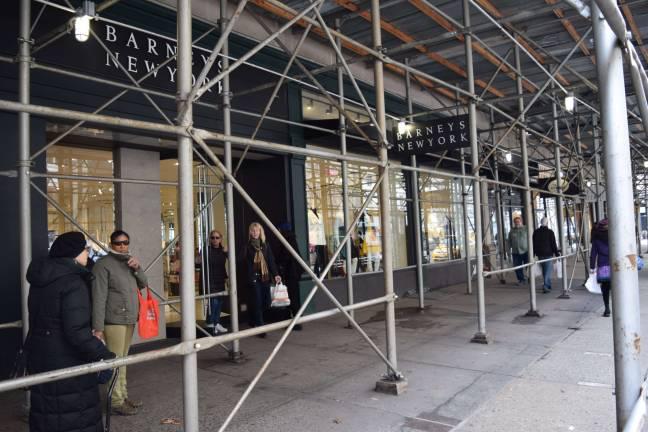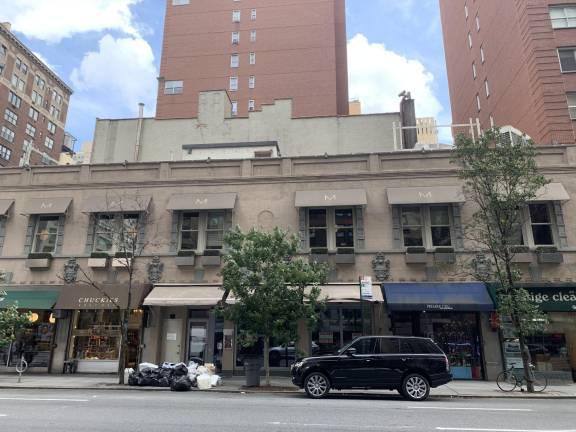The Rent Isn't Too Damn High Anymore
Manhattan retailers get a long-overdue break, as rental costs finally come crashing back down to earth


Looking to rent a vacant storefront in the iconic retail corridor running up Broadway between West 72nd and 86th Streets?
Now may be the best time in years to lock up a lease and cash in on the foot traffic that encircles Fairway, Citarella’s and Zabar’s.
Hoping to cater to the ultra-rich who shop on the glittering stretch of Madison Avenue between East 57th and 72nd Streets?
Relative rental bargains can be found for the posh boutiques a short stroll from Baccarat and Brunello Cucinelli, La Perla and L’etoile Royale.
With large blocks of space sitting empty or underutilized for months or years, ground-floor retail rents have finally started to tumble in almost every market across Manhattan, a new report found.
In the 14-block strip of Broadway on the Upper West Side that takes in the shuttered Barneys store on 76th Street, average asking rents per square foot plunged 14 percent, from $306 in 2018 to $263 today.
The corridor’s free fall is even more dramatic when compared to its post-recession peak of $341 in the fall of 2016 – from which it fell 23 percent, according to data from the Real Estate Board of New York.
Meanwhile, across the park on East 86th Street between Second and Lexington Avenues, where the new Old Navy just opened its doors, the rent dropped 11 percent from last year to $327 per square foot today – and 27% from its high of $450 just two years ago.
Bottom line: REBNY, the industry’s largest trade association analyzed 17 major retail strips between the Battery and West 125th Street and found that average asking rents declined in 11 of them, or 65 percent, over a one-year period. Just four posted gains; two were unchanged.
Even more precipitous price collapses – in 14 of the 17 corridors, or 82 percent – were reported over a three-year period in markets as diverse as Herald Square and Soho, Greenwich Village and Fifth Avenue from the Plaza District to 42nd Street, REBNY found.
Is the Retail Apocalypse at Hand?
Consider Bleecker Street between Seventh Avenue South and Hudson Street, where average asking rents ticked down just five percent, from $293 per square foot in the fall of 2018 to $278 today.
But rents on that trendier portion of Bleecker had hit a post-recession, all-time high of $471 in the fall of 2016 – and they’ve been plummeting ever since, chalking up a staggering 41 percent drop over three years, REBNY research shows.
The numbers correspond to soaring vacancy rates in almost all the key retail corridors. Simply put, landlords had raised rents sky high as the economy recovered from recession, scaring off tenants even as cyber-shopping cut demand – and they’re now discounting them steeply to fill empty spaces and recapture the same shopkeepers they drove away.
But the retail outlook is hardly dire, REBNY insists: Deal-making is healthy. With daunting asking rents falling, an uptick in year-over-year leasing activity has resulted. Retailers are now gravitating to unique in-person experiences like smaller pop-ups and promotional spaces as supply surges. And online brands have inked short-term leases to attract real-world, in-store shoppers.
“New experiential concepts will continue to buoy the market moving forward,” said James Whelan, president of REBNY.
The semi-annual, fall 2019 “Manhattan Retail Report” found that the declining rents present new opportunities to fill the rising number of empty storefronts as operators seek to enter or re-enter the market. It claims the outlook is positive, if challenging, as landlords dangle new incentives and proffer bargains and flexibility in rent negotiations.
“Prospective long-term tenants remain selective, yet activity continues to be strong in today’s market,” Whelan added.
Despite the downward trend, retail rents soared 22 percent on lower Broadway between the Battery and Chambers Street; 14 percent on a prime block in the Meatpacking District, 14th Street between Ninth and Tenth Avenues; and eight percent on West 125th Street between Fifth and Morningside Avenues.
The broader falloff, REBNY says, is a “continuation of a multi-year market correction.” Still, whole swaths of the Manhattan retail scene seem either battered or transformed.
A New Hermes, a New Armani
Exhibit A may be Madison Avenue: “Out of the 17 observed corridors, it experienced the largest year-over-year decline,” the report says.
The crown jewel of American retailing, it posted average asking rents per square foot of just $906 this fall, falling below the symbolic $1,000 mark for the first time in years for ground-floor space between East 57th and 72nd Streets.
By comparison, the street commanded rents of $1,160 in 2018, before a sharp 22 percent falloff, and a top-dollar price of $1,446 in 2017, before a seismic decline of 37 percent.
Large numbers of expiring leases contributed to high availability rates on Madison, leading owners to soften rents and offer more short-term lease deals, the report says. As a result, space is now being absorbed and several recent leases consist of retailers moving into smaller-sized storefronts, often with co-tenants.
“Lots of brands are taking a look, testing the place out, coming into the neighborhood – and their spaces are being priced accordingly,” said Matt Bauer, president of the Madison Avenue Business Improvement District since 1999.
Indeed, 36 new tenants have arrived on the avenue since July, the BID says.
“Not every new store is permanent, some are pop-ups and short-terms leases ... But you read about the retail apocalypse, and here you have all these major brands investing on Madison Avenue,” Bauer added.
He cited three luxury boutiques, the faux-fur purveyor Maison Atia, which opened in October under a short-term lease; women’s clothing store Lingua Franca, which signed a longer lease; and fashion accessory Frances Valentine, which came in as a pop-up, then decided to make its tenancy long term.
“Are there more vacancies than we would want? Absolutely, and what you’re seeing is a response by property owners to what’s happening in the marketplace,” Bauer said.
Those changes span the global retail landscape, and they’ve fueled a vacancy rate of around nine percent in the BID’s territory, which runs from 57th to 86th Streets.
The avenue’s signature tenants are also on the move. Giorgio Armani plans to redevelop its flagship store, tearing it down and rebuilding on site with ultra-luxe residences on top, and Hermes says it will move up the avenue and across the street to a new flagship location by 2022.
Meanwhile, in some retail strips, brokers evince a measure of optimism that rents may have bottomed out and opportunities abound.
In a stretch of Broadway in Soho between Houston and Broome Streets, for instance, asking prices have collapsed 12 percent, from $558 a year ago to $491 today. More dramatic still, the quarter plunged 40 percent from its historic post-recession peak of $812 in 2017.
“Wow! I have a couple of cIients who just might – might – be able to afford those prices,” said Sammy Williams, a downtown real estate broker.
invreporter@strausnews.com
“Wow! I have a couple of cIients who just might – might – be able to afford those prices.” Sammy Williams, downtown real estate broker